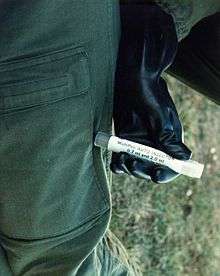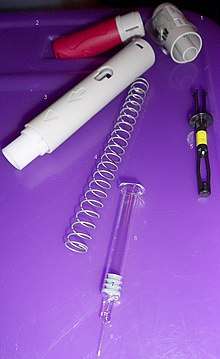Autoinjector
An autoinjector (or auto-injector) is a medical device designed to deliver a dose of a particular drug.

Most autoinjectors are spring-loaded syringes. By design, autoinjectors are easy to use and are intended for self-administration by patients, or administration by untrained personnel. The site of injection depends on the drug loaded, but it typically is administered into the thigh or the buttocks. The injectors were initially designed to overcome the hesitation associated with self-administration of the needle-based drug delivery device.
Design

The autoinjector keeps the needle tip shielded prior to injection and also has a passive safety mechanism to prevent accidental firing (injection). Injection depth can be adjustable or fixed and a function for needle shield removal may be incorporated. Just by pressing a button, the syringe needle is automatically inserted and the drug is delivered. Once the injection is completed some auto injectors have visual indication to confirm that the full dose has been delivered. Autoinjectors contain glass syringes, which can make them fragile and vulnerable to contamination. More recently, companies have been looking into making autoinjector syringes out of plastic to prevent this issue.
Another design has a shape and size of a smartphone which can be put into a pocket. This design also has retractable needle and automated voice instructions to assist the users on how to correctly use the autoinjectors. The "Auvi-Q" epinephrine autoinjector uses this design.[1]
Examples

- Epinephrine autoinjectors are often prescribed to people who are at risk for anaphylaxis. Brand names include Anapen, EpiPen, Emerade, and Auvi-Q.
- Rebiject, Rebiject II and Rebidose autoinjectors for Rebif, the drug for interferon beta-1a used to treat multiple sclerosis. An autoinjector for the Avonex version of this same medication is also on the market.
- SureClick autoinjector is a combination product for drugs Enbrel or Aranesp to treat rheumatoid arthritis or anemia, respectively.
Military use
- Autoinjectors are often used in the military to protect personnel from chemical warfare agents. In the U.S. military, atropine and 2-PAM-Cl (pralidoxime chloride) are used for first aid ("buddy aid" or "self aid") against nerve agents. An issue item, the Mark I NAAK (Nerve Agent Antidote Kit), provides these drugs in the form of two separate autoinjectors. A newer model, the ATNAA (Antidote Treatment Nerve Agent Auto-Injector), has both drugs in one syringe, allowing for the simplification of administration procedures. In the Gulf War, accidental and unnecessary use of atropine autoinjectors supplied to Israeli civilians proved to be a major medical problem.[2]
- In concert with the Mark I NAAK, diazepam (Valium) autoinjectors, known as CANA, are carried by US service members.
Variants
A newer variant of the autoinjector is the gas jet autoinjector, which contains a cylinder of pressurised gas and propels a fine jet of liquid through the skin without the use of a needle. This has the advantage that patients who fear needles are more accepting of using these devices. The autoinjector can be reloaded, and a variety of different doses or different drugs can be used, although the only widespread application to date has been for the administration of insulin in the treatment of diabetes.[3][4]
See also
References
- Thomas, Katie (1 February 2013). "Brothers Develop New Device to Halt Allergy Attacks". New York Times. Retrieved 6 March 2017.
- Baren, Jill M.; Rothrock, Steven G.; Brennan, John; Brown, Lance (2007-10-24). Pediatric Emergency Medicine. Elsevier Health Sciences. p. 1069. ISBN 978-1437710304.
- "1". Mendosa.com. 2001-01-16. Retrieved 2010-07-07.
- 2 Archived April 11, 2007, at the Wayback Machine
-solution.jpg)

